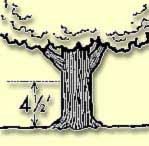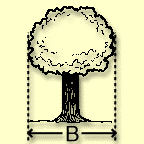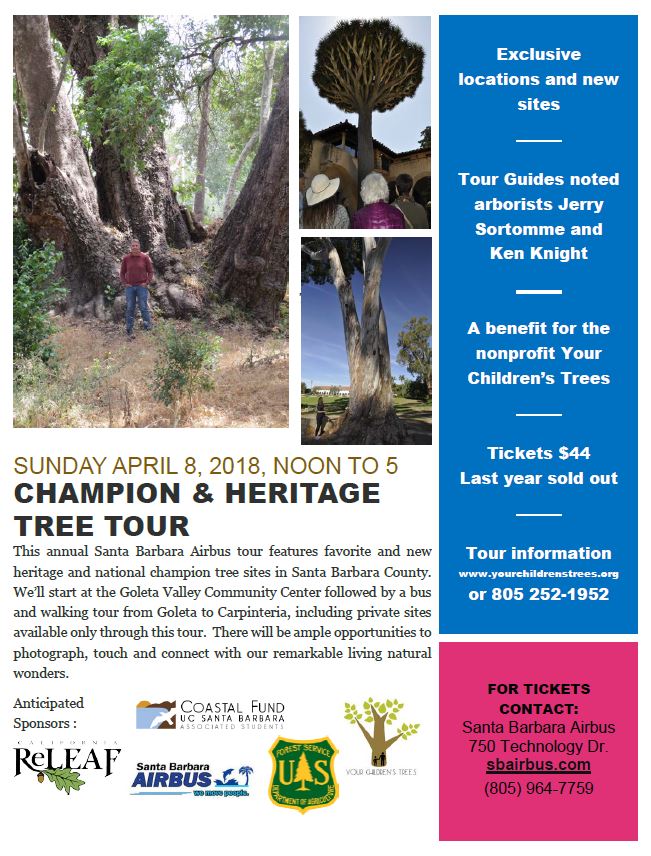Helpful Resources
One of my hobbies is to search for big and champion trees. For the last sixteen years, Jerry Sortomme and I lead an annual tour of the national champion trees in Santa Barbara County. I welcome you to our next tour on April 8, 2018. You can also get involved in the search and nomination process yourself. See the information below, or call me at (805) 252-1952.
How to Nominate a Big/Champion Tree
Locating a tree to nominate is the first task in the nomination process. The easiest way to do this is to keep your eyes open when outside! Keep in mind that not all champions are giants. Look for both naturalized and native species, as well as shrub species. For example, the National Champion Pacific Rhododendron grows in Mendocino County, with a circumference of 20 inches, height of 33 feet and crown spread of 20 feet.
Searching for a specific tree species may be a good way to begin your big tree search. There are several books that can provide information to help with identification. Your local forester may also help. You will also need the current register to see how your tree measures up to the current champion. Keep in mind that current champs can be "dethroned" and that there are several species without a state champion. A nomination form must be filled out for each tree.
California Big Tree Website - californiabigtrees.calpoly.edu
American Forests National Champions website - www.americanforests.org/explore-forests/americas-biggest-trees
Points Formula
The California Register of Big Trees uses American Forests' formula to determine whether a tree is a champion.
Trunk circumference in inches
+ Height in feet
+ 1/4 of the crown spread in feet
= Total Points
Circumference
To measure the tree's circumference, measure around the tree at 4-1/2 feet above the ground on the tree's uphill side. If the tree forks below or bulges at 4-1/2 feet, measure the circumference where the tree reaches normal size or tapers below the 4-1/2 foot point. For accurate measurement, use a diameter tape or regular tape measure.


Height
Measure the height from the ground level to the highest point. You can measure height with an instrument such as a clinometer, hypsometer or abney. It is also possible to compare the tree to something of known height, such as a 25-foot building. American Forests also recommends the following method: Hold a straight stick at its base, vertically at arm's length. The stick's length above your hand should equal the distance from your hand to your eye. Walk back from the tree, staying level to the tree's base. Stop when the stick above your hand is the same length as the tree. Sight over your hand to the base of the tree, and sight over the stick to the top of the tree. Measure how far you've moved from the tree. That measurement, in feet, is the tree's height.
The Indiana Division of Forestry recommends another method of measuring tree height. First, temporarily mark a spot 4 feet from the base of the tree to serve as a sighting point. Back away from the tree, holding a yardstick vertically in front of you. It must be straight for an accurate measurement. Stop when the 4-foot section of the tree occupies exactly 1 inch of the yardstick. Sight to the base and the top of the tree, noting the number of inches the entire tree height occupies. Multiply that number by 4 feet to determine the total tree height.
Crown Spread
To find the tree's average crown spread, measure the widest point and the narrowest point of the crown. Add them together and divide by two to calculate the average crown spread.
Widest part of tree.Narrowest part of tree.
B. Narrowest part of tree.


Bottom view of tree showing both the widest and narrowest part of the tree.
Formula for computing the tree's average crown spread:
A + B = Total Feet
Total Feet / 2 = Average Crown Spread
Points Formula
The California Register of Big Trees uses American Forests' formula to determine whether a tree is a champion.
Trunk circumference in inches
+ Height in feet
+ 1/4 of the crown spread in feet
= Total Points
When two trees are within 10 points of each other, they are co-champions.
